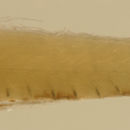en
names in breadcrumbs


Diagnosis: Modal fin-ray counts of D-VI,11 A-10 (rarely 10/9) Pect-17 indicate Erotelis smaragdus or Gobiomorus dormitor. These genera have overlapping fin-ray counts, and given the inconsistent ranges reported in the literature, these cannot be relied on to distinguish the taxa. Leptophilypnus fluviatilis, from Panama, may rarely overlap the dorsal and anal-fin-ray counts (10/10), but has 18-19 pectoral-fin rays. Larvae and recruits of Gobiomorus dormitor differ in having a large eye and a melanophores only on the first anal-fin membrane. The larvae of the eastern Pacific sibling species, Erotelis armiger, shares the melanophore pattern. G17
Analogues: The eleotrid larvae share a long thin body with relatively short dorsal and anal-fin bases, numerous procurrent caudal-fin rays, and a long ventral midline streak from the isthmus to the mid-abdomen. Larval Erotelis smaragdus are distinguished by a row of melanophores along the anal-fin membranes and a characteristic spot on the peduncle midway along the ventral procurrent caudal-fin rays.
Description: Body very thin, long and narrow with a medium eye and a terminal medium-sized mouth. Pelvic fins separate and long, pectoral fins long, dorsal and anal-fin bases medium length (the base of the second dorsal fin can be almost the same length as the caudal peduncle behind the fin (or at least more than two-thirds) and the rays are of roughly even length), caudal peduncle long and relatively narrow and there are many procurrent caudal-fin rays in a distinct fleshy fold, typically about 12-14 in this larval type. Markings mostly along the ventral midline: melanophores usually as streaks (but sometimes contracted and appear as spots) extending from the isthmus most of the way to the vent (about 10), ending at the swim bladder (which is the full thickness of the abdomen and provides a clear view of the retroperitoneum). There is a row of melanophores along the bases of the fourth and fifth and then the last several anal-fin elements (variably paired) and continuing as several streaks along the ventral peduncle ending at the start of the lower procurrent caudal-fin rays. There are melanophores on the membranes between all of the anal-fin elements. There is a gap of melanophores at the start of the ventral procurrent caudal-fin rays followed by a patch of melanophores on the mid procurrent rays and then heavy pigmentation over the bases of the lower segmented caudal-fin rays extending along the full length of the lower segmented caudal rays as well as on the mid and distal portions of the central and sometimes the upper segmented caudal-fin rays. The central and upper portion of the end of the caudal peduncle is covered by surface melanophores. A small and often inconspicuous melanophore is frequently present on the dorsal midline of the caudal peduncle just forward of the start of the procurrent caudal-fin rays. Head markings on all individuals include melanophores at the angle of the jaw, along the dentary at the tip and below the dentary just to the side of the tip of the lower jaw. Head markings on some individuals include melanophores on the inside dentary of the mid-lower jaw, the rim of the mid-maxilla, the tip of the upper jaw, and below the nasal bones. Melanophores extend over the iris on the dorsal half of the eyeball and around the sides of the base of the eyeball and, when expanded, melanophores cover most of the outer half of the iris ring. Many individuals have a hidden melanophore overlying the cleithrum visible upon lifting the operculum (variably paired) and most have a melanophore along the insertion of the lowest pectoral-fin ray. Internal melanophores surround the saccule and are present along the dorsal surface of the swim bladder and paired around the gut near the vent. There is a linear internal melanophore above the pelvic girdle, perhaps along the ventral postcleithrum. There are prominent internal streaks extending along the hemal spines from the vent level rearwards (starting at the ventral midline melanophores and extending upwards toward the vertebral bodies and then occasionally even above). Series of transitional larvae show development of the eye from a moderately narrowed vertical oval, no tilt, with the pupil off-center dorsally and a posterior-inferior extension of the iris and/or melanophores (there is often a marked dorsal and ventral indentation of the iris as well), to fully round. Transitional larvae develop a pattern of large discrete melanophores speckling the upper half of the head, around the nasal bones and along the upper and lower jaws as well as internally around the posterior brain case. Surface melanophores develop along the lateral midline from the caudal peduncle forwards.
Erotelis smaragdus larva
Erotelis smaragdus larva
Erotelis smaragdus larva
Erotelis smaragdus larva
Erotelis smaragdus larva
Erotelis smaragdus larva
Erotelis smaragdus larva